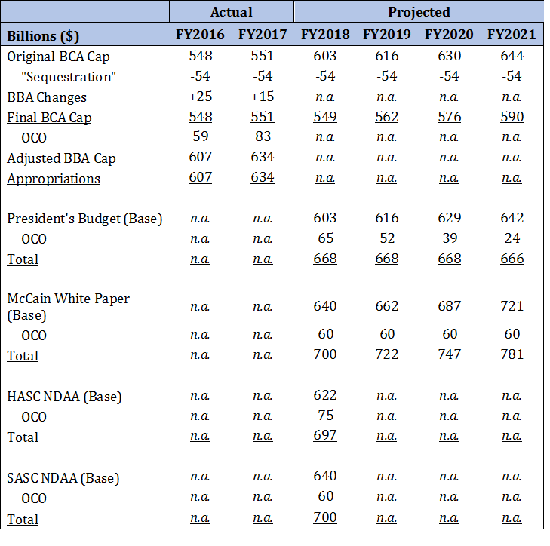The Daily Dish
July 3, 2017
Funding National Security
Tomorrow the United States will turn 241 years old. While we celebrate the nation’s birth on July 4th, July 2nd, 1776 is when Congress actually voted to free the U.S. from British rule.
AAF would like to extend special birthday greetings to Douglas Holtz-Eakin’s mother, Mary Elizabeth Eakin, who turns 85 years young today.
Eakinomics: Funding National Security
On the eve of celebrating the birth of this nation, it seems appropriate to review the state of play on defending it. More specifically, on the various considerations regarding the fiscal 2018 (and beyond) defense budget. The basic lay of the land is summarized in the table below. Recall that the Budget Control Act of 2011 (BCA) imposed caps on defense (and non-defense) discretionary spending and imposes an across-the-board sequester to cut spending back to meet the cap. The first two lines show the impact of passing the BCA. In 2015, the Bipartisan Budget Act (BBA) raised the caps for 2016 and 2017; this is shown in the third and fourth lines.
Finally, recall that the BCA caps so-called “base” Pentagon funding; there is separate funding outside the cap for “overseas contingency operations” (OCO). This feature is intended to permit the Pentagon to meet the need for a surge of funding in the event that troops are deployed overseas. However, in recent practice it has become a way to get more funding into the Department of Defense (DoD) without raising the cap. This is a highly imperfect approach, however, since not all defense funding needs are present in the OCO accounts.
So much for recent history. The president requested $603 billion in base funding for 2018 — well above the cap of $549 — and another $65 billion in OCO for a total of $668 billion. That is a relatively sharp increase. Note, however, that the budget appears to show total funding requests as unchanged over the near future. In practice, the administration states that funding levels for FY2019 and beyond will be driven by the forthcoming National Security Strategy, National Defense Strategy, and Nuclear Posture Review.
The administration is not the only player in the defense-needs area. Senate Armed Services Committee (SASC) Chairman John McCain developed a white paper that called for sharply higher base funding in 2018, steady growth over the next several years, and a total of $2.6 trillion over the next four years.
Meanwhile, the House Armed Services Committee (HASC) and its Senate counterpart, SASC, have been busy developing their versions of the National Defense Authorization Act (NDAA) for fiscal 2018. As shown in the table, both are in the vicinity of $700 billion of total funding, with the HASC devoting substantially more to OCO (although $10 billion of it is intended to meet base funding needs). The $32 billion gap between the president’s budget and HASC/SASC reflects a desire to address the list of “unfunded priorities” that the armed services delivered to Congress. As a note, both the SASC and HASC NDAAs contain an additional $8 billion for programs falling under the defense caps, but outside the jurisdictions of the armed services committees.
What’s the bottom line? First, there is a consensus that defense spending must rise; do not look to the Pentagon for easy deficit reduction over the next several years. (This does not mean that there could not be substantial reforms to the composition of the defense budget.)
Second, the NDAA and the BCA budget caps are on collision course. Obviously, the goal should be to raise the defense cap for 2018 (at least) in the next few months, but in the future Congress will need to reconcile the gap between the scope of the Pentagon’s mission and their willingness to fund it.
Third, the politics are about to get complicated. How much more non-defense spending will Senate Democrats demand as the price of raising the defense cap? (Recall that Obama demanded a matching $1 for every $1 increase in the defense cap. How far apart will the NDAA be from the authorized appropriations, given that on Thursday the House Appropriations Committee passed by voice vote on a bill that would only appropriate $658 billion? Finally, where will be the spending cuts needed to make raising the caps budget-neutral?
The politics of threading the needle on health care reform and tax reform have garnered the bulk of the public attention recently. The defense funding problem, however, is just as challenging.
Fact of the Day
1863 Battle of Gettysburg ends
1775 Washington takes command of Continental Army
1863 Pickett leads his infamous charge at Gettysburg
1985 “Back to the Future” released, features 1981 DeLorean DMC-12












